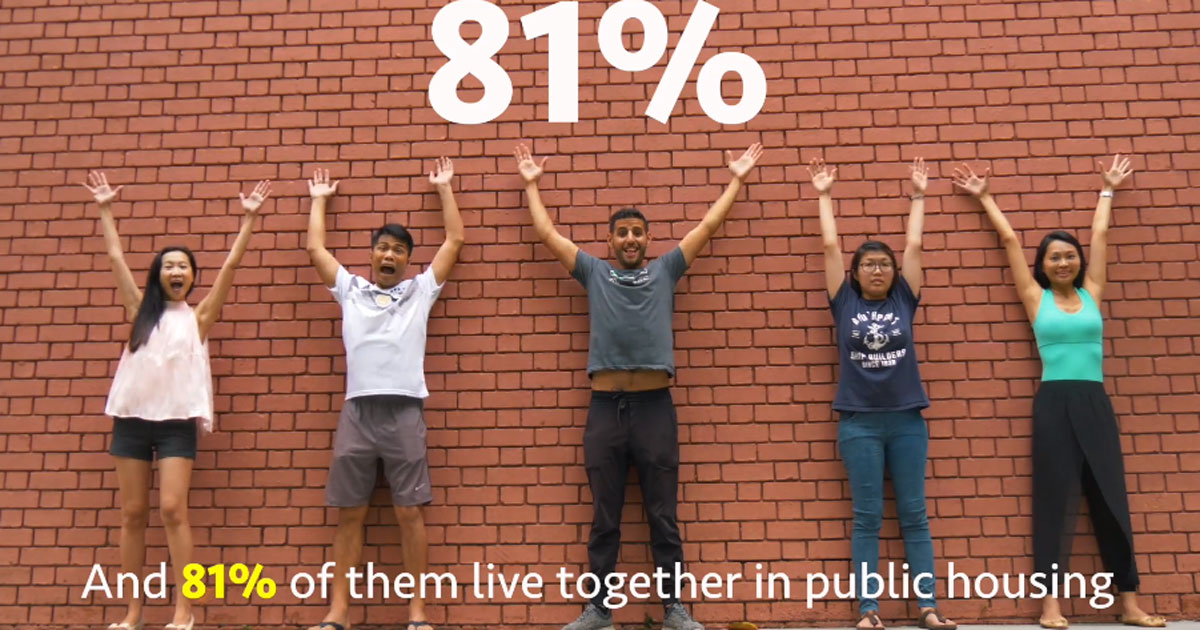Nas Daily is angry -- despite having arrived in Singapore.
He is angry because he grew up not having Jewish friends as a result of being Arab.
So, what is his solution?
He has made a new four-minute video to convey his dismay and then setting it up to praise Singapore's ethnic quota public housing policy, which he claims, has prevented ethnic segregation and further downstream problems.
Prefaced video with apology
Having been stung previously by criticisms that his videos are simplistic and ride roughshod over difficult topics, this latest Nas Daily video is prefaced with an apology.
The video caption said:
I want to start this with an apology.
I'm sorry - I have become extreme with my views and extreme with my videos. I have lived through tens of years of segregation and I think my frustration is slowly showing in the videos.
If you think my approach to this topic is too extreme or simplistic, then I understand. I can see why. But I strongly believe the problems we face today need strong solutions. And I'm more than happy to start the debate.
Enjoy watching the video. It took me years to muster the courage to do it.
What video is about
The first half of the video by Nas, also known as Nuseir Yassin, opened with the premise that many countries in the world are facing ethnic segregation.
London, for example, despite its cosmopolitan status, has developed racial enclaves because people divide themselves up according to their ethnicity.
"The people are diverse, but they live separately," Nas said.
This has led to shortfalls in government spending on certain areas where minorities congregate and has prevented integration.
Nas said problems then result: "And that's how you get a country within a country. The government will under-fund you, and ignore you."
He also highlighted the problem with clips of right-wing nativists upping their rhetoric stemming from this lack of integration.
Singapore solution
Midway through the video, Nas holds Singapore up as the shining beacon of hope that things could be different from everyone else -- if they do what we did.
For example, Nas said in the video that out of 100 Housing & Development Board apartments in an estate, there are about "74 Chinese families, 13 Indian families and 13 Malay families", so "it is impossible to only have 100 percent of of any race in public housing".
Nas even interviewed HDB's Housing Policy Development department policy implementer:

The Singaporean said categorically he has friends from all ethnic groups.
What is this ethnic quota?
The Ethnic Integration Policy (EIP) was introduced in 1989 to discourage the forming of racial enclaves in Singapore.
It is more commonly referred to as the "HDB ethnic quota".
The aim was to make every neighbourhood here a microcosm of society at large.
The impetus for such a policy was the government’s recognition of Singaporeans forming certain ethnic enclaves.
Bedok, for example, was inhabited predominantly by Malays, while the Chinese favoured settling in Hougang.
With quotas, there are limits set on the total percentage of a block or neighbourhood that may be occupied by a certain ethnicity.
These limits are updated on the 1st of every month. (You can check here.)
They are meant to reflect the racial composition in Singapore -- which led the video to summarise as a situation of having 74 Chinese families, 13 Indian families and 13 Malay families in a given block of flats.
This allows people to buy and sell flats if they’re of the same ethnicity.
But if they want to buy or sell from someone of a different ethnicity, they will only be able to do this if the sale won’t result in the percentage of that ethnicity going over their allotted quota.
Problems with ethnic quota
However, there are also criticisms with ethnic quotas -- and this is the portion Nas ought to be apologising for because it is not in his video.
For example, Chinese-constrained HDB resale units tend to be more expensive than Malay or Indian-constrained units -- owing to the disparity in earning and purchasing power of different ethnic groups.
There is also the phenomenon of vacant leftover units in an area with Build to Order flats, as these are only available for Malay applicants but with no takers.
In Singapore, children of mixed-race marriages are entitled to register a double-barrelled race -- an offspring of Malay and Chinese parents, for example, can register as a Malay-Chinese or Chinese-Malay.
Under the current EIP policy, only the first race component of the double-barrel may be used.
As a Chinese-Malay, this person would then be restricted by the quota restrictions imposed on Chinese occupants, regardless of the fact that she technically is also half Malay.
With the numbers of mixed-race marriages on the rise, about one-fifth (or 21.5 percent) of all marriages in 2015 were mixed-race couples, the EIP policy is not as well-calibrated to take into account mixed-race children.
And this has been five minutes, see you next time.
Previously:
If you like what you read, follow us on Facebook, Instagram, Twitter and Telegram to get the latest updates.
